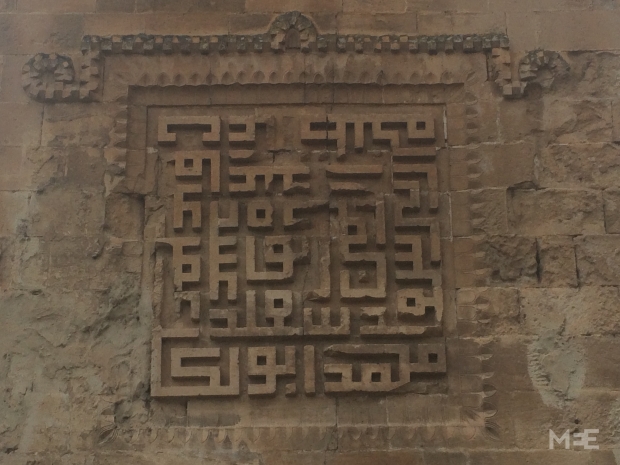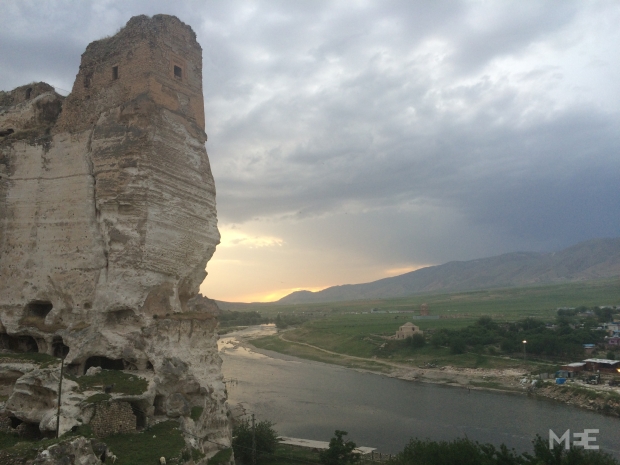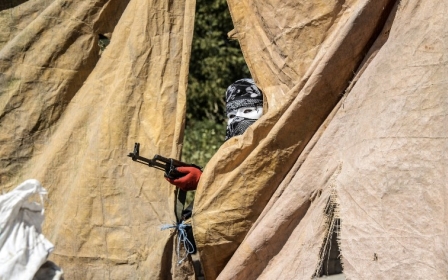Hasankeyf: The 12,000-year-old town that Turkey wants to drown
HASANKEYF, Turkey - Over the banks of the mighty Tigris, lightning flickers and the valley booms with a white flare. For a second, the rows of boxy little stone houses that dot the riverbank are illuminated before the hills fall dark.
This is Hasankeyf. People have called it home for 12,000 years. Caves pepper the lush green hills, where evidence of human habitation goes back to the Neolithic period. The Romans used it as a military bastion. Constantine the Great had the city fortified before it became the Byzantine Bishopric of Cephe.
The Turkmen Artukid and Kurdish Ayyubid Islamic dynasties changed its name to Hisn Kaifa and developed a medieval Islamic capital, whose traces remain. Today, the soaring minarets of the two most important mosques stand sentinel against this Silk Road skyline, in a bend on the seductive river.
This will all disappear if authorities have their way. It is estimated that 80 percent of the ruins and Hasankeyf town will, by 2019, be submerged under 10.4 billion cubic metres of water held back by the Ilısu Dam. The controversial construction project - funded by Turkish banks after funding from EU countries was pulled – has been under construction on the Tigris since 2006.
New MEE newsletter: Jerusalem Dispatch
Sign up to get the latest insights and analysis on Israel-Palestine, alongside Turkey Unpacked and other MEE newsletters
Authorities claim that the dam – part of the multi-billion dollar South-eastern Anatolian Project (GAP) – will generate electricity and bring wealth into the region, one of Turkey’s poorest. Locals will be rehoused and the medieval monuments that draw in tourists will be relocated.
But locals, fiercely proud of old Hasankeyf and the communities it represents, are less than happy.
“My grandfather and grandmother lived for 55 years in a cave, 45 years in the town, and then died on the same day,” says Ozzy, a Hasankeyf resident vehemently opposed to the dam project. “What about their legacy? Now it will be flooded.”
Ercan, a business owner in central Hasankeyf who does not want his full name used for fear of speaking out about the dam, thinks along the same lines: “I am young, I can go to a new city and learn new things. But for the old people here, it is not so easy. And this is my home. Seven generations of my family have lived in Hasankeyf.”
A community displaced
The Tigris is clearly the centre of life here. On a sunny April day, fishing nets cast shadows over the river’s surface. Groups of teenagers dunk themselves under it. Elaborate picnics are prepared on the banks and a full barbecue smokes away on one stretched-out rug.
Once the tourist coaches leave for the day, the mood is subdued. Residents sit in the twilight in cafes astride a dusty road. They are clearly mindful that their homes will be flooded.
Hasankeyf is a rare example of pre-Ottoman medieval Islamic town planning in Turkey: it is divided into a fortress, outer gardens, and a merchants’ centre. Seljuk-era roads trace their way beside the 12th century Artukid Old Tigris Bridge.
Among the blockbuster heritage sites at risk include two striking places of worship: el-Rizk Mosque, built by the Ayyubids in 1409, and the Sultan Suleyman Mosque two years its junior. Those who look closely will see elaborate tiling and Kufic script.
On the opposite bank, the tomb of Zeynel Bey wears turquoise tiles and red brick decoration - the only example of Timurid architecture in Turkey. It looks sadly dilapidated, standing against a backdrop of honey-coloured cliffs and poppies.
Hasankeyf meets nine of the 10 criteria for inclusion on the UNESCO World Heritage list. But critics accuse the Turkish government of cynical apathy about applying for such status because protection would hinder industrial ambitions around the dam.
In a recent paper for the Centre for Policy and Research on Turkey, Harriet Fildes wrote that the 200 feet rise in water levels would mean, “systematically destroying the cultural and historical value of this ancient city as well as the people who inhabit it”.
In March, Hasankeyf was voted among the most endangered heritage sites in Europe by Europa Nostra, a leading cultural organisation that said there was “no internationally recognised scheme” for the relocation and protection of the town’s monuments.
There are also believed to be vast troves of Roman, Byzantine and other pre-Ottoman era treasures, from busts to coins, in cliffsides next to Hasankeyf. Locals say – not entirely in jest – that it would take 500 years to uncover everything regarding its 10,000-year-long history.
In May, at a symposium held in Hasankeyf, speakers from the local working group said there would be “serious and substantial losses” to natural and cultural heritage if the dam construction was finished as planned.
The grand relocation
Hasankeyf’s main monuments will be saved and locals’ livelihoods saved, according to the government. An open-air museum of the most significant historical attractions – disassembled piece by piece and then reconstructed – will open on the hills on the opposite river bank.
There are also said to be plans for boat trips to the citadel, which standing high on the cliffside would be an island in the future reservoir.
“Archaeologists and scholars from Turkey and several other countries are at work on a project to excavate, record, and preserve as much as possible,” the Foreign Ministry said in a terse statement on the subject.
Yet the plans do not impress people living in Hasankeyf. One local working in the tourism industry claimed that the government had spent 55m Turkish Lira on reinforcing the monuments in preparation for relocation, but that the new attractions would not lure visitors.
“OK, so they plan to move four or five pieces – the two minarets, the Zeynel Bey Tomb – to new Hasankeyf. But it will all be fake. It is like a flower, if you pick it, it is no longer real."
He laughed at plans for underwater tourism around the old bridge’s stumps. “How will they do that? The water is not clean here. It is a joke."
Speakers at the symposium cited a previous example of a sacrificed settlement. Halfeti, 110km from the city of Gaziantep, is partially sunk below the reservoir created by the Birecik dam, completed in 2000. But the critics said, “its spirit and identity were destroyed,” and that it emphasised how “cultural and social progress of human communities is more important than physical development”.
Too fragile to move?
Scaffolding visible around the bridge and the Zeynel Bey tomb indicates the plans to stabilise and relocate Hasankeyf’s heritage is underway.
“But how will you take the minaret to the other side?” cries local resident Ercan. “No engineer can do that.”
Many fear the monuments are too fragile to be relocated. Abdulvahap Kusen, Hasankeyf’s mayor, has previously told local media that he feared “potential incompatibility” between the tomb’s building materials, and the relocation process.
“The surviving elements are very fragile,” according to a report by Dr Zeynep Ahunbay and Dr Ozge Balkız on Hasankeyf’s “Outstanding Universal Value.”
“They are subject to weathering and pressures from tourism and dam construction.”
Murat Tekin owns an Aygaz bottled gas and shoe shop in Hasankeyf, and speaks on behalf of the community opposed to the dam.
Sitting behind a small glass window inside his shop, cigarette smoke, wires and shoeboxes trailing around him, he sighs.
He is cynical about current restoration, believing it is taking place only to obliterate Hasankeyf later.
His family has lived in the town for generations, but it has become harder to work here since the Ilısu Dam was first mooted in the 1950s.
“It is more and more difficult to live here. Before, people used to have tourist bazaars inside the caves, but now this is forbidden.”
He believes the closure of the citadel area in 2012 on supposed safety grounds was the authorities’ way of deterring tourists and building a case for flooding the town. “If people don’t have any money, then they will support the dam.”
Centuries-old homes will be lost
Even if the mosques and the Zeynel Bey tomb are saved, vernacular architecture will be lost to the waters. The cultural heritage formed by people’s homes and the homes of their forefathers is most at risk.
Opponents say that the Ilısu Dam will displace up to 80,000 people in a largely Kurdish region, although the government stresses there are people of “different ethnic origins” in the area.
Young Kurdish women here feel uninformed and despondent. “This is the home of the Kurdish people,” they say, gesturing at the houses built into the cliffside. “We don’t know what is happening, and when it will happen if this does all sink.”
New Hasankeyf
Among the undulating green hills on the opposite river bank sit the building blocks of new Hasankeyf. This is where the government wants to resettle people, within tantalising view of their old homes.
There are apartments, the shell of a hospital, a football court, mosque and a smart conference hall. The latter seems far removed from the daily needs of the local population, and residents say they will avoid moving in as long as they can.
“Hasankeyf’s people will stay in the old town as long as possible – four or five years – as they don’t want to come here,” explains Murat Tekin. “But the government wants them to move as soon as this is all ready – in about two years.”
But while residents’ houses in the old town are being bought for around 80,000 TL, a new apartment on this side of the river will cost 175,000 TL. That leaves many residents with an uncertain future because the government will not be providing housing or covering the difference in costs.
In old Hasankeyf, the storm lifts the next morning. The sun shines on the rust-and-honey coloured minarets, at least for now.
This article is available in French on Middle East Eye French edition.
Middle East Eye delivers independent and unrivalled coverage and analysis of the Middle East, North Africa and beyond. To learn more about republishing this content and the associated fees, please fill out this form. More about MEE can be found here.









